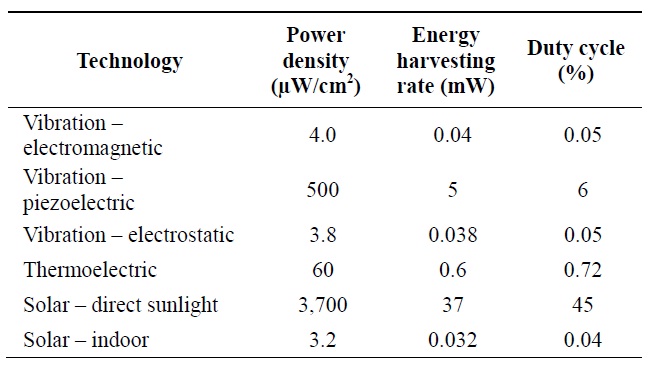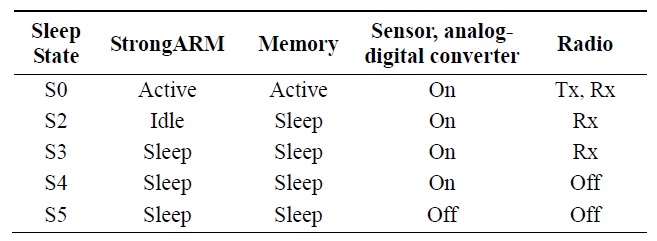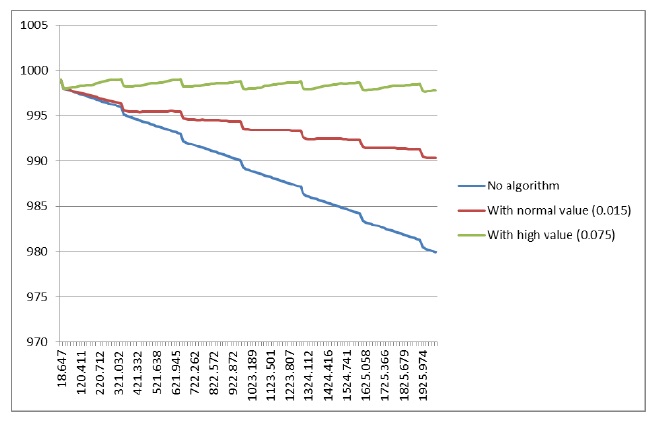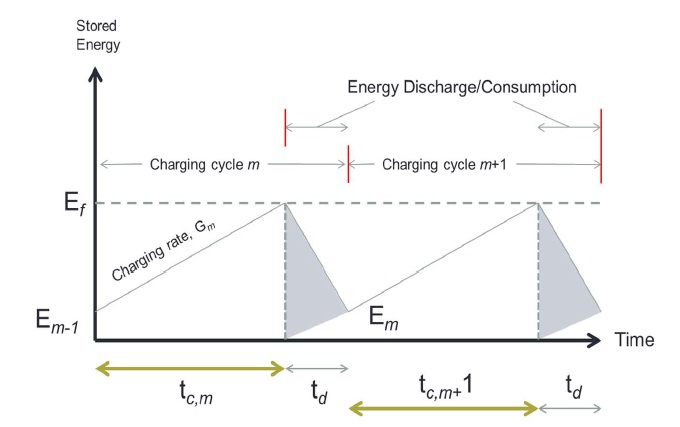



The advances of technology have enabled the fast development of tiny, low power devices capable of performing sensing and communication tasks. In the past decade, sensor networks have emerged and received high attention of many researchers [1]. Over the years, wireless sensor networks have been widely adopted to monitor conditions over large areas [2]. These nodes have been used to monitor physical and environmental properties which include but are not limited to temperature, pressure, motion, luminosity, vibration, water acidity and even toxic levels.
These nodes are left unattended for long durations - years and even decades. In order to prolong the network lifetime, it is necessary to minimize the consumption of energy by individual nodes. Much effort has been put in researches involving efficient energy consumption and researchers have acknowledged that a critical aspect in the design and efficient implementation of wireless sensor networks is to save energy and keep the network functional for as long as possible [3].
One of the techniques that have greatly attracted researchers in the field is tree-based routing for wireless sensor networks. Tree-based routing algorithms are poweraware. Each node chooses a parent node - a node where it transmits its data based on the remaining energy level of the nodes. The tree based algorithm chooses the optimum path based on the remaining energy levels of the nodes by calculating the cost of transmitting and receiving data.
Aside from energy aware algorithms, energy harvesting has also attracted the attention of researchers. Unlike power sources that are fundamentally energy reservoirs, energy harvesting (aka energy scavenging) is a means of powering wireless sensor nodes by harvesting various low grade ambient energy sources such as environmental vibrations, human power, thermal sources, solar, wind energy and their conversion into useable electrical energy [4]. The process simply replenishes the energy of the nodes and lengthens the lifetime of the network. Combining low-power electronics, capacitors and energy harvesting devices, we can extend the lifetime of the network without relying on the harvested energy or the batteries alone [5].
Even if a harvesting structure is implemented on each sensor, without energy management through sleep scheduling, there is a possibility that some of the nodes will start losing power. This will happen when the nodes are not given enough time to properly replenish their energy or manage it using a sleep scheduling scheme that is aware of its harvested energy. Sleep schedules allow for graceful energy-quality scalability so that the mission lifetime can be extended if the application demands, at the cost of sensing accuracy.
In this paper we propose an energy-aware sleep scheduling (EASS) scheme that identifies the amount of harvested energy. The level of sleep on individual nodes will be based on this harvested energy. The EASS will be implemented on an existing tree-based routing algorithm with an energy harvesting structure.
The rest of this paper is organized as follows. In Section II, the network model, energy model, workload model and energy aware sleep scheduling concept will be discussed. In Section III, the expected outcomes of the proposal will be presented. Finally, Section IV will contain all information regarding the simulation model, expected results and conclusion.
An energy harvesting structure is implemented to improve an existing tree-based algorithm [6]. The tree-based algorithm chooses the optimum path based on the remaining energy levels of the nodes. It maintains a main root or branch of nodes to be kept awake for a certain period while the rest of the nodes switch to sleep mode while recharging the batteries.
The functional lifetime of the routing protocol will be greatly optimized by implementing an energy harvesting structure. The paths are chosen by means of the remaining energy levels of the nodes and the cost of sending data from one node to its parent node. By having paths chosen at different times, the energy of any single path will not deplete quickly [7]. This can achieve longer network lifetime as energy is dissipated more equally among all nodes. Network survivability is the main metric of this research.
There are many existing devices in the industry today that are capable of producing electricity by harvesting wasted energy from the environment. Table 1 shows the different power densities of some of the most widely used energy harvesting technologies. Solar energy from direct (outdoor) sunlight performs best when compared to other ambient energy sources.
In this paper, we assume that the sensors are equipped with solar panels. The available environmental energy may vary at a single node. At the same time, there may be variations of the harvested energy for different nodes. This is because the harvested solar energy supply is highly time varying and may not always be sufficient to power the whole network. Another reason could be the placement of the sensors on the deployment environment e.g. some sensors will be in the shade, solar panels not tilted to an optimum angle towards the sun, etc.
In this paper, we focus on spatial variations of environmental energy and assume that each node u has an individual harvesting power rate pu > 0. The solar energy harvesting rate will be calculated based on the power density of the solar cells for both indoor and outdoor usage and the average power consumption of the sensor device for both transmission and receive states. The harvested energy is stored in a storage device (e.g., a supercapacitor) and we denote the stored energy E
The node u has available energy E
[Table 1.] Achievable duty cycle by MICAz with 10 cm2 harvesting material [5]

Achievable duty cycle by MICAz with 10 cm2 harvesting material [5]
Based on the capacity of the secondary storage devices and the average consumption of the devices, the duty cycle of the harvested energy will also be calculated to replenish the batteries regularly. The duty cycle of the application determines the ratio of the time when harvested energy is used to the time when it is not used (recharging) [8].
We have developed an energy harvesting algorithm to serve the needs of this research. In this algorithm, we were able to come up with a minimum energy harvesting value for a solar energy harvesting device which can enable to node to last for a longer period of time after deployment.
Fig. 1 shows the results of this algorithm. It presents 3 different graphs: 2 of which used energy harvesting and the other one without energy harvesting.
We assume that no data compression or in-network aggregation is performed. Although in-network processing is critical to sensor network lifetime, such process will not be applied here. All packets are forwarded to the base station for processing.
>
D. Energy Aware Sleep Scheduling
A sleep scheduling scheme will be implemented to each node in the network. When the nodes are classified as “ leaf nodes”, they will be switched to sleep state and wait for any event to occur to wake up and transmit the data.
[Table 2.] Useful sleep states for the sensor node

Useful sleep states for the sensor node
Different levels of sleep consume different amounts of energy and will also require varying amounts of energy when switched back to active state. The deeper the sleep state of a sensor node, the more energy will be required to switch it back to active state to start receiving or transmitting data. The nodes that are switched to a deeper state of sleep are those with higher harvested solar energy. The ones with lower harvested energy will have a lighter state of sleep so that they will require less power when waking up, prioritizing the reception and transmission of data before going back to sleep mode. Before switching into sleep state, the nodes will first determine how much energy has been harvested in the super capacitor. When back to sleep mode, the node will continue replenishing its energy source.
Table 2 enumerates the component power modes corresponding to five different useful sleep states for the sensor node. Each of these node sleep modes corresponds to an increasingly deeper sleep state and is therefore characterized by an increasing latency and decreasing power consumption.
In EASS, the level of sleep will depend on the amount of energy. If a node has more energy, it will be switched to a deep sleep state and switched to a lighter state if otherwise.
If (harvested energy>threshold) { Node.Sleep_State = 0;
}
If (harvested energy < energy_range_1){ Node.Sleep_State = 1;
}else if(harvested energy < energy_range_2){ Node.Sleep_State = 2;
}else if(harvested energy < energy_range_3){ Node.Sleep_State = 3;
}else if(harvested energy < energy_range_4){ Node.Sleep_State = 4;
}
III. FUTURE WORK AND EXPECTED RESULTS
Results in [6] shows that when the proposed EASS protocol is compared with the performance of GSP, there’s a significant difference in the time when the first nodes start dying. In the simulations in [6], each node was initialized with a residual energy of 2,000 joules. In this case, the proposed protocol has only 5?20% active nodes during the interval when the nodes have not yet started dying, while in the case of GSP, this percentage is about 75% in all cases. As a result, in GSP, the nodes start dying earlier in comparison to the proposed protocol.
When the number of nodes was increased to 500, the first node to become dead in the proposed protocol occurs much later as compared to that in GSP. Results showed that each node loses energy much slowly in the proposed protocol in comparison to that in GSP.
In this experiment, an energy harvesting structure is assumed to be present on each node. The proposed protocol in [6] will be improved by implementing an energy aware sleep scheduling scheme that will determine the level of sleep of each node by analysing the amount of solar energy harvested.
The energy aware sleep scheduling scheme will greatly improve the performance of the network when compared with that in [6]. The following results are expected of the experiment:
1) Number of packets delivered will be increased because the nodes have significantly more energy available.
2) Number of packets lost will be decreased due to the equal energy consumption among the nodes resulting to fewer node deaths during the network’s lifetime.
3) Functional lifetime will be increased.
Packet loss will be decreased as well as packet transmission delay due to the fact that the time at which the first nodes start dying is delayed. Implementing an energy harvesting structure will also ensure the availability of almost all of the nodes during the entire existence of the wireless sensor network.
The results in Fig. 1 illustrate the energy model concept used in [9] which is shown in Fig. 2. Each charging cycle
Switching a sensor node from a deeper state of sleep to an active state needs a lot of energy and extra time. This would cause energy overhead and time latency [10] As a future work, when this energy-aware sleep scheduling scheme is applied to a sensor network, the
IV. DISCUSSION AND CONCLUSIONS
In this study, an energy harvesting structure is going to be implemented over a tree-based routing protocol to greatly increase the energy efficiency of the wireless sensor network. A tree structure is formed in wireless sensor network where the sensor nodes are uniformly distributed in an area. A central connection of nodes is formed based on the calculated costs at the beginning of each period. These nodes remain awake for a single period while the other nodes called the leaf nodes put their processors to sleep so as to save energy.
This scheme, when implemented with an energy harvesting structure, will have its performance greatly increased by delaying the time at which the first nodes start dying. This positively affects the throughput of the network as well as decreasing the delay at which data is sent from source to sink.
In [10], the researchers designed a dynamic power management strategy in a sensor node to reduce the power consumption. They also defined 5 sleep states as shown on Table 2 as well as a sleeping policy for the sensor nodes.
In the sleeping policy presented in [10], deepest sleeping probability was determined by an “ n-duplicate-covered” method. An “ n-duplicate-covered” node means that there are more than (n+1) nodes in that particular area. Contrary to the method of [10], in this research, deepest sleeping state will be determined by identifying the amount of energy harvested.
To the best of our knowledge, this is the first proposal for a sleep scheduling scheme that is aware of the harvested energy. Future work on this proposal will include full implementation of the algorithms and the sleep scheduling scheme. The study should also include improvement in the duty and sleep cycles of the wireless sensors. Careful observation and experimentation on the different amounts of energy consumed by wireless sensors will help researches in improving the cycles at which harvested energy is used for the nodes activities.


![Achievable duty cycle by MICAz with 10 cm2 harvesting material [5]](http://oak.go.kr/repository/journal/11536/E1ICAW_2012_v10n3_264_t001.jpg)


